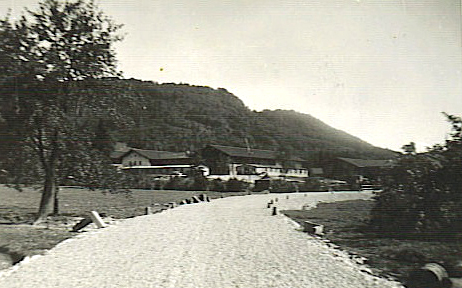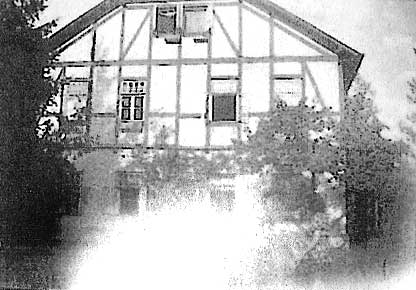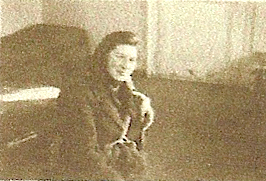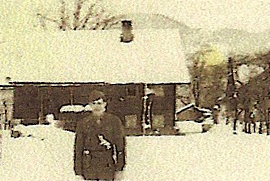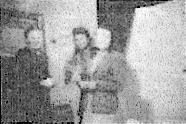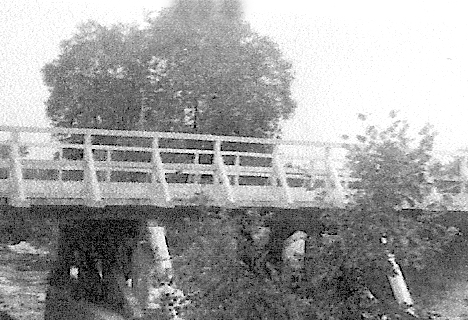Glasenbach and Rauchenbuchler Displaced Persons Camps
by Andrew Stabins / Mississauga, Ontario, CanadaI was in DP Camp Glasenbach from 1945 to 1949 (age 7 to 11). I fled with my parents from Latvia by train via Danzig, Vienna to Bad Ischl and after the end of WW II to a camp at the edge of Salzburg called Rauchenbuchler.
To the best of my recollection it was at the northeast edge of the city on higher ground above railway yards. I could hear the trains shunting but not see them. There were farm fields just outside of camp to the north or the east. It was south of the then unfinished east west Autobahn and within easy walking distance from a bridge on that highway. I remember walking under it to get to another camp on the other side of the Autobahn, the name of which camp I do not remember.
The Rauchenbuchler camp was of wooden barracks which in retrospect seemed to have been built during the war. The barracks were not old, were clean and I remember that they formed a single square with a yard in the middle where we played as kids. In late 1945 or early 1946, we were all moved to DP Camp Glasenbach located on the east side of Salzach River at the foot of the old army camp then occupied by US troops. The US army occupied substantial barracks of brick and some buildings were 2 stories high.
Our camp had about 20 barracks made of wood and had probably been added to the older existing army base before or during WW II. The US Army grounds were fenced off and separate from the DP camp. People with trades in the DP camp such as my father, who was a carpenter, found work on the army base. This Camp Glasenbach is not to be confused with the camp of the same name across the Salzach River which was then an internment camp for former Nazi party members and special POW's.
The DP Camp in Glasenbach held Latvians, Estonians, Lithuanians, Ukrainians, probably some Poles and I remember some kid telling us that he was from Turkey (!). I believe that it was a mixed population, however we the kids at that age stuck with our own and did not know the languages of the other nationalities there and I must rely on my memories of what I was told by others as to the nationalities in camp.
Some of the Latvians left for camps in Germany and the rest emigrated mostly to Canada in 1948 to 1949 to Ontario to either the Toronto area or to work for Ontario Hydro in the Nipigon area and then to Niagara Falls in construction. We heard rumours that the camp was closed in early 1950's. Everyone who we knew had left by then and there was no reason to write to anyone at the camp. Except for my mother who is now 90 years old and still active all the parents of the kids from the camp who came to Canada are now dead and some of the kids in the gang have also passed on.
My mother still has a couple of dozen pictures from Camp Glasenbach times of 60 years ago. I have some vivid memories of life there and then, but they are only useful to me, since that slice of life at that time is of little interest to those who were not there. Anyway, Camp Rauchenbuchler may be an obscure place and it may only have been an interim or temporary camp. I have not met anyone else who was there and all the other Latvian refugees in Glasenbach came from other locations.
If you wish, you can add Rauchenbuchler (or Rauchenbuechler) to your list. Finding someone else from that camp may be analogous to the proverbial needle in the haystack, but then, stranger things have happened before.
11/16/06 Olga:
With this message I am forwarding a current satellite-aerial
photos of the Camp Glasenbach as it is today.
To the West, running north-south are the Salzach River and the main double tracked
railway line.
The DP Camp area is the "oval" area in the centre of the pictures now occupied by condos. The US Army camp was in the "triangular area" to the East of the DP Camp and still appears to be occupied by barracks. This is the pre-war Rainerkaserne of the Austrian Army. When I was in camp in 1946-1949 the area to the west of the camp to the railway was either pasture or with crops. The area between the railway and the river was wooded where we gathered firewood, played, picnicked. There were no houses to the south or to the north except for a farm to the northwest just north of the railway underpass. West of the underpass the US Army constructed a very sturdy wooden bridge to connect to the west bank of Salzach which led to among other things to the Heilbron Castle which was the former summer residence of the Bishops of Salzburg. North of the "camp oval" was some kind of a low bunker which we never could explore because it was dark. I think that it was an ammunition storage bunker.
The Glasenbach River (Creek) at top running east to west was shallow in the summer and full of raw sewage. At bottom right corner there is still a small wooded hill. At its most western end was a barn and the garbage dump for the US Army camp where we were able to obtain copies of comic books, Life magazine and other American cultural artifacts which we could trade with other kids in other camps for marbles. (The good stuff at the dump was picked over first by an adult gang of some particular Slavic nationality.) Basically the camp was then in a rural are with only the US Army camp as a significant neighbor. The bus to Salzburg stopped at the base of the "triangle" and is the square one mentioned earlier by one of the former camp residents.Andrew Stabins
3/17/05 Hello Olga,
We actually moved into DP Camp Glasenbach, part of the small Camp Truescott,
in 1948 as a pre-condition for getting visas to emigrate to America. Up to
that point my father, a stateless Russian, was unable to qualify for a visa.
I remember the pleasant humid swampy ground with giant "umbrella" plants between the camp and the Salzach River. It was a polyglot camp with Poles, Ukrainians, and others I don't recall. I briefly had a Russian playmate named Petya, who was tiny but had an amazingly deep, loud voice. There was large box-like bus that stopped at the end of a lane, past a burning garbage heap, to take us into Salzburg. We promptly nick-named it in Russian "karopka," "the box." When
I revisited the area in 1969, there were only some fragments of wire fences
and buildings of Camp Truescott standing, and no sign of the Camp Glasenbach
barracks. We emigrated through Hanover and crossed the Atlantic in a pitching
troop carrier called the Admiral Bundy in the winter of 1948. I puked all the
way. We stayed with my aunt in Cleveland, Ohio for a year, and finally came
to rest in California. I hope this will be useful to someone. My mother Anna
will remember more details than I have given in this brief summary. Thank you
for preserving all these memories of us DPs. Cordially yours, George Vinson, Turlock, California
UNRRA Team 191 Glasenbach:
P. Gullion
V. Nichols
C. Schuffart
P. Porges
E. Geiger
J. Heynderick
J. Dekelper - Dr.
J. Luton - Dr.
Ethel Ostry was the principla welfare worker in Camp Glasenbach.
Dear Ms. Olga
Attached you will find several pictures. We are searching in all directions
and hoping that we soon get some clues to this story.These pictures were
in the possession of Marieanne Koch/Dobrainsky's husband, and we hope
that someone will recognize someone or the countrysite. Thank you for
your help.
Aug 12, 2019
I am in the process doing some research for my uncle Benjamin Nathan Rippe, who was the Commandant of the Glasenbach. I found on your site and what Andrew wrote fascinating.
Some of my uncle Ben's military service is a bit unclear, but working on it. I know far more of other areas of his time in the Army between 1942 and 1946 than his time in Austria. So any info I have is still up in the air to me, and can not 100% so far be accurate. Maybe you could give me a bit of help on Glasenbach and all this.
Photo of one of Ben's favorite items he brought back from Glasenbach in early 1946. Thought you would be interested to see.
Ben brought the marble keepsake home and kept it for the rest of his life.
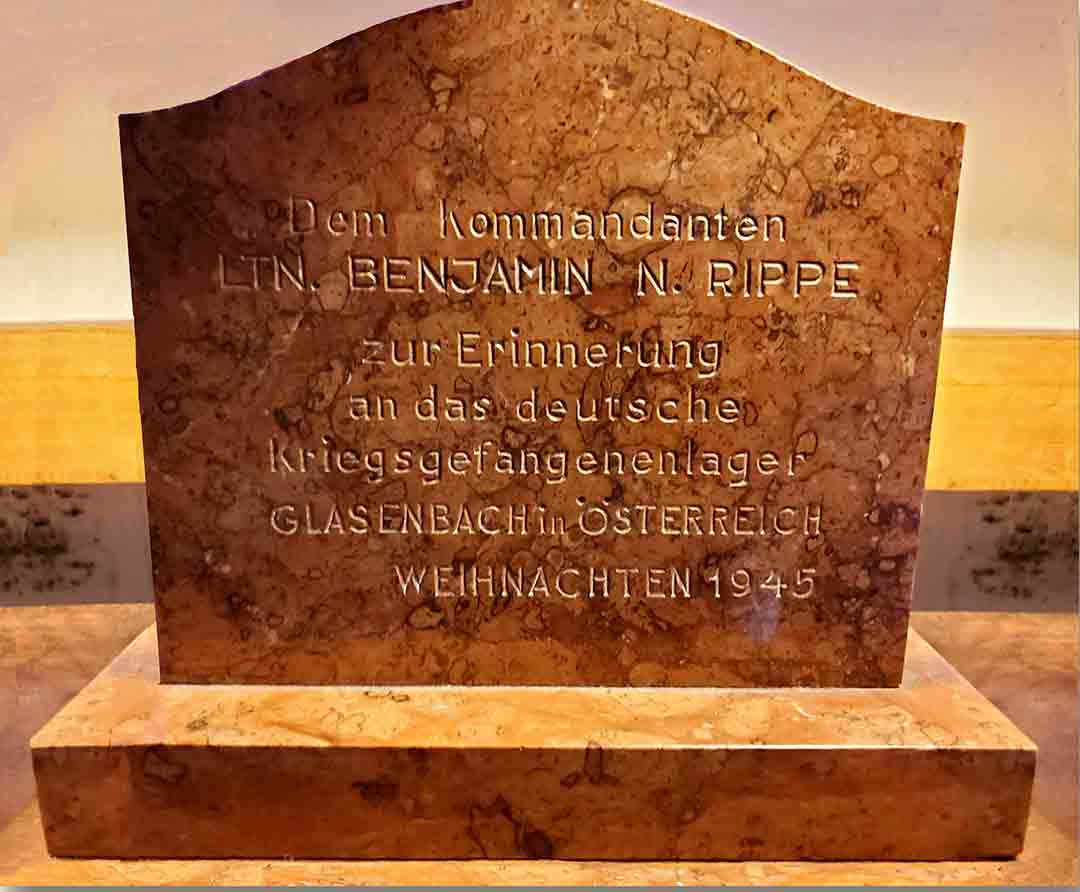
Lt. Benjamin Nathan Rippe-Marble Statue-
German POW Camp,
Salzberg, Austria-1945
This paragraph explains the image attached and is extracted from the Bio I am completing for my site. http://markerickson.com
In late 1944, Rippe began serving as a Provost Marshal. Some of the duties of a Provost Marshal are handling investigations and incarcerations of U.S. Army personnel.
In 1945, Lt. Rippe served as the Commandant of a Displaced Persons/Prisoner of War camp in Glasenbach, near Salzburg, Austria. The German prisoners respected Commandant Rippe to such a degree they carved a small marble monument in his honor and presented it to him. It reads: 'To Commandant Lt. Benjamin N. Rippe: In memory of the German prisoners of war camp Glasenbach, Austria. Christmas 1945.'
Love to hear from you and will check back at the computer when we return to the studio.
Many thanks, best, Mark Erickson markericksonstudio@gmail.com
Elena Erickson - Paintings
https://elenaerickson.com/
Mark Jon Erickson - Paintings
http://markerickson.com/home.html
